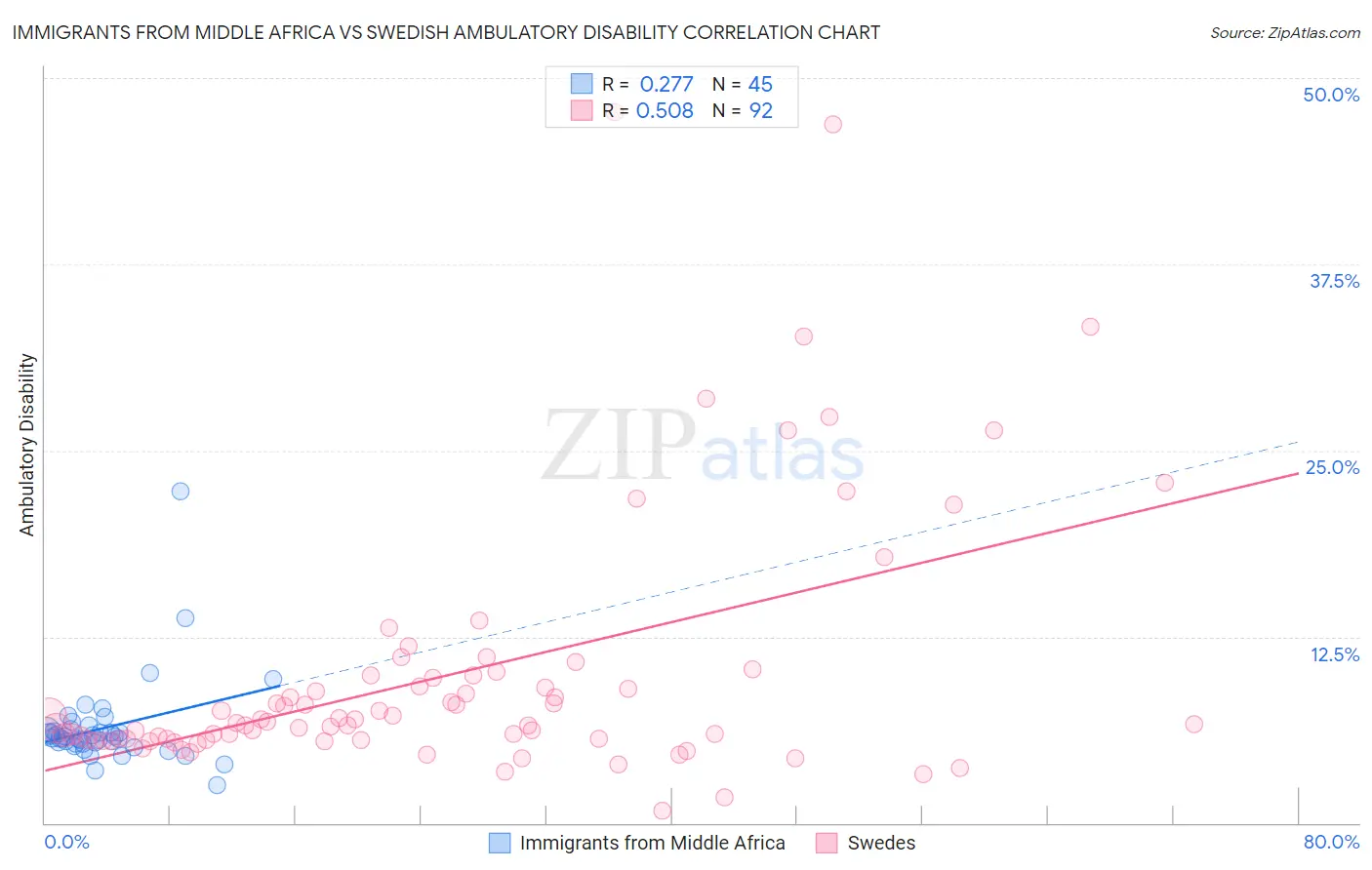Immigrants from Middle Africa vs Swedish Ambulatory Disability
COMPARE
Immigrants from Middle Africa
Swedish
Ambulatory Disability
Ambulatory Disability Comparison
Immigrants from Middle Africa
Swedes
5.9%
AMBULATORY DISABILITY
92.2/ 100
METRIC RATING
124th/ 347
METRIC RANK
6.0%
AMBULATORY DISABILITY
83.1/ 100
METRIC RATING
141st/ 347
METRIC RANK
Immigrants from Middle Africa vs Swedish Ambulatory Disability Correlation Chart
The statistical analysis conducted on geographies consisting of 202,691,189 people shows a weak positive correlation between the proportion of Immigrants from Middle Africa and percentage of population with ambulatory disability in the United States with a correlation coefficient (R) of 0.277 and weighted average of 5.9%. Similarly, the statistical analysis conducted on geographies consisting of 538,852,545 people shows a substantial positive correlation between the proportion of Swedes and percentage of population with ambulatory disability in the United States with a correlation coefficient (R) of 0.508 and weighted average of 6.0%, a difference of 1.2%.

Ambulatory Disability Correlation Summary
| Measurement | Immigrants from Middle Africa | Swedish |
| Minimum | 2.5% | 0.84% |
| Maximum | 22.3% | 47.7% |
| Range | 19.7% | 46.9% |
| Mean | 6.4% | 9.9% |
| Median | 5.7% | 6.7% |
| Interquartile 25% (IQ1) | 5.3% | 5.6% |
| Interquartile 75% (IQ3) | 6.2% | 9.8% |
| Interquartile Range (IQR) | 0.93% | 4.3% |
| Standard Deviation (Sample) | 3.0% | 8.7% |
| Standard Deviation (Population) | 3.0% | 8.6% |
Demographics Similar to Immigrants from Middle Africa and Swedes by Ambulatory Disability
In terms of ambulatory disability, the demographic groups most similar to Immigrants from Middle Africa are Immigrants from Russia (5.9%, a difference of 0.040%), Icelander (5.9%, a difference of 0.060%), Korean (5.9%, a difference of 0.12%), Arab (5.9%, a difference of 0.14%), and Immigrants from Nigeria (5.9%, a difference of 0.24%). Similarly, the demographic groups most similar to Swedes are Immigrants from Philippines (6.0%, a difference of 0.010%), Czech (6.0%, a difference of 0.020%), Immigrants from Zaire (6.0%, a difference of 0.050%), Immigrants from Hungary (6.0%, a difference of 0.080%), and Immigrants from North Macedonia (6.0%, a difference of 0.10%).
| Demographics | Rating | Rank | Ambulatory Disability |
| Icelanders | 92.6 /100 | #122 | Exceptional 5.9% |
| Immigrants | Russia | 92.4 /100 | #123 | Exceptional 5.9% |
| Immigrants | Middle Africa | 92.2 /100 | #124 | Exceptional 5.9% |
| Koreans | 91.6 /100 | #125 | Exceptional 5.9% |
| Arabs | 91.5 /100 | #126 | Exceptional 5.9% |
| Immigrants | Nigeria | 90.9 /100 | #127 | Exceptional 5.9% |
| Immigrants | Western Asia | 90.7 /100 | #128 | Exceptional 5.9% |
| Immigrants | Norway | 90.5 /100 | #129 | Exceptional 5.9% |
| Immigrants | Kazakhstan | 89.7 /100 | #130 | Excellent 5.9% |
| Immigrants | Costa Rica | 89.5 /100 | #131 | Excellent 5.9% |
| Immigrants | Europe | 87.8 /100 | #132 | Excellent 6.0% |
| Immigrants | Immigrants | 86.9 /100 | #133 | Excellent 6.0% |
| Ute | 86.6 /100 | #134 | Excellent 6.0% |
| Immigrants | Italy | 85.0 /100 | #135 | Excellent 6.0% |
| Immigrants | North Macedonia | 84.1 /100 | #136 | Excellent 6.0% |
| Immigrants | Syria | 84.1 /100 | #137 | Excellent 6.0% |
| Immigrants | Hungary | 83.9 /100 | #138 | Excellent 6.0% |
| Immigrants | Zaire | 83.6 /100 | #139 | Excellent 6.0% |
| Czechs | 83.3 /100 | #140 | Excellent 6.0% |
| Swedes | 83.1 /100 | #141 | Excellent 6.0% |
| Immigrants | Philippines | 83.0 /100 | #142 | Excellent 6.0% |